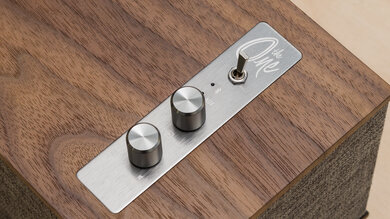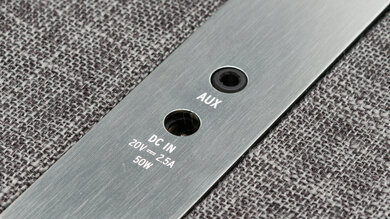The Klipsch The One II is a vintage-style Bluetooth speaker with a similar design to the Klipsch The Three II, though it's a bit smaller in size. It can get pretty loud, and there's an AUX input you can use to wire older devices to the speaker. It has a boomy sound profile that adds some punch to the bass, though it can muddy vocals and lead instruments. Unfortunately, it also lacks low-bass, so you can't feel the deep thump and rumble in bass-heavy music, and there aren't any sound customization features like a graphic EQ or presets to tweak its sound to your liking.
Our Verdict
The Klipsch The One II is alright for music. It has a boomy sound profile that adds some punch to the bass, though it can also muddy vocals and lead instruments. That said, like most speakers its size, it lacks the thump and rumble in the low-bass range that fans of bass-heavy music like hip-hop and EDM tend to enjoy. Unfortunately, there aren't any sound customization features you can use to tweak its sound to your liking. However, this stereo speaker can still get pretty loud, though there's some compression present at max volume that can affect the quality of your audio during louder listening sessions.
- Gets loud.
- AUX input.
- No graphic EQ.
- Lacks low-bass.
The Klipsch The One II isn't bad for watching videos and movies. It has low Bluetooth latency with iOS and Android devices, so your audio is in sync with the visuals on your screen. That said, some apps compensate for latency differently, and your experience may vary. The speaker can also get pretty loud, though its boomy sound profile can muddy dialogue. Unfortunately, its directivity is disappointing, resulting in a narrow and directional-sounding soundstage.
- Gets loud.
- Low iOS and Android latency.
- No graphic EQ.
- Compression present at max volume.
The Klipsch The One II is unremarkable for podcasts. Its boomy sound profile can muddy voices and dialogue, and there aren't any sound customization features to tweak its sound to your liking. It also isn't very portable due to its wired design, making it bothersome to transport from room to room in your home. While it can get pretty loud, there's some compression present at max volume that can affect the quality of your audio at louder volumes. Its directivity is also sub-par, so you can't hear your audio as clearly from all angles.
- Gets loud.
- AUX input.
- No graphic EQ.
- Compression present at max volume.
The Klipsch The One II doesn't support voice assistants.
The Klipsch The One II isn't designed to be used outdoors and needs to remain plugged into a power outlet for it to work.
Changelog
- Updated Nov 27, 2023: Added market comparison with the JBL Authentics 200 in the Voice Assistant box.
- Updated Sep 18, 2023: Added market comparison for the Klipsch Groove XXL in the Portability box.
- Updated Jan 27, 2022: Review published.
- Updated Jan 25, 2022: Early access published.
Check Price
Differences Between Sizes And Variants
The Klipsch The One II comes in two color variants: 'Walnut' and 'Matte Black'. We tested the 'Walnut' variant, you can see its label here. We expect both variants to perform similarly.
If you see any other variants of this speaker, let us know in the discussions, and we'll update our review.
Popular Speaker Comparisons
The Klipsch The One II is a similar speaker to the Klipsch The Three II, though it's smaller and doesn't feature Phono Pre-Amp and ground inputs to connect it to a turntable. Like the Three II, it can get pretty loud and comes with an AUX input you can use to wire it to your devices. Both speakers have similar sound profiles, though vocals and lead instruments can sound slightly less muddy on the One II. Unfortunately, there aren't any sound customization features to tweak its sound to your liking. Also, unlike other home speakers we've tested, it doesn't support voice assistants and can't be connected to your Wi-Fi network.
Check out our recommendations for the best home speakers, the best smart speakers, and the best Bluetooth speakers for bass.
The Klipsch The One II and the Klipsch The Three II are similar speakers. The One II is smaller, and its sound profile's mid-range is slightly better balanced, resulting in vocals and lead instruments that sound more present in the mix. That said, the Three II can get louder and features Phono Pre-Amp and ground inputs you can use to connect a turntable to the speaker. It also supports USB Audio, meaning you can wire your devices to the speaker via its USB-B port.
The Amazon Echo Gen 4 is a better speaker than the Klipsch The One II overall. The Amazon speaker offers outstanding voice assistant support with Alexa built-in. It has better directivity, resulting in a wider-sounding soundstage. It also features bass and treble adjustments to customize its sound to your liking. That said, the Klipsch can get louder than the Amazon speaker and has lower Bluetooth Latency with iOS and Android devices.
The Denon Home 350 is a better speaker than the Klipsch The One II. The Denon's sound profile is a bit better balanced and can produce a more extended low-bass than the Klipsch. It also features bass and treble adjustments to customize its sound to your liking, and it's Wi-Fi compatible. That said, the Klipsch can get a bit louder than the Denon and has lower Bluetooth latency with iOS and Android devices, though some apps compensate for latency differently, and your experience may vary.
The JBL Authentics 200 is a more feature-packed speaker than the Klipsch The One II. They're both wired-only home speakers with retro designs. However, the JBL has built-in voice assistant support, unlike the Klipsch. It also offers sound customization features and a room correction tool.
Test Results

The Klipsch Heritage Wireless One II is a rectangular speaker with a vintage-inspired design like the Klipsch The Three II, though it's a bit smaller in size. It sits horizontally on its four feet and comes in two colors: 'Walnut' and 'Matte Black'. We tested the 'Walnut' variant.
The Klipsch The One II is a bit smaller and lighter than the Klipsch The Three II. That said, it isn't very portable due to its wired design and needs to remain plugged into a power outlet for it to work, so you can't easily move it from room to room. The Klipsch Groove XXL is a battery-powered alternative from this manufacturer if you want something more portable.
The Klipsch The One II's build quality is alright. Its top and bottom are covered by real wood veneer, and the rest of its body is tightly wrapped in a sturdy fabric. The speaker's switch and knobs and the metal plate on its rear are made of an aluminum-like metal. While its power switch is a bit loose and swivels a bit, it doesn't impact its ability to switch the speaker on or off. The One II sits on four plastic legs with rubber underneath them to keep the speaker from slipping or moving around. Since it doesn't have an IP rating for dust and water resistance, we recommend against placing it in areas where it may get wet, like near your kitchen sink or in the bathroom.
It offers a selection of basic controls that are simple and easy to use. There's a switch to turn the speaker on/off and two knobs to control the speaker's volume level and chosen input. You can press the input knob to set the speaker in Bluetooth pairing mode, and there are lights to inform you of your selected input. However, there isn't any feedback to inform you of your selected volume level, and you can't use the speaker's physical controls to skip your tracks or play/pause your audio, so you need to do so via your paired device or audio source.
The Klipsch The One II's frequency response accuracy is okay. It has a boomy sound profile that adds some punch in the bass range. However, like other speakers of its size, it lacks thump and rumble in the low-bass range typically present in bass-heavy music like hip-hop and EDM. The underemphasis in the mid-range can cause vocals and lead instruments to sound a bit muddy and be pushed to the back of the mix. Unfortunately, the speaker doesn't come with sound customization features like a graphic EQ, so you can't adjust its sound to better suit your preference.
The Klipsch The One II's soundstage is alright. Like the Klipsch The Three II, it can play stereo content without downmixing it to mono. However, it has disappointing directivity, so your audio may not sound as clear from all angles, and its soundstage can be perceived as narrow and directional.
This speaker's dynamics are good. While the manufacturer says the speaker can reach a maximum volume level of 103dB, it could only reach a maximum volume level of 99.1dB in our tests with the volume on the speaker and our paired testing phone maxed out. That said, this is still incredibly loud, and the speaker should have little trouble filling a large room with sound. Unfortunately, there's some compression present at max volume that can affect the quality of your audio when the speaker is pushed to its louder volume levels.
The JBL Authentics 200 is a good alternative if you want a retro-looking speaker with built-in voice assistants.
Aside from its power input, the Klipsch The One II features an AUX port on its rear you can use to wire other devices to the speaker. Unfortunately, unlike the Klipsch The Three II, it doesn't come with a USB port to use for audio playback or a Phono Pre-Amp and ground inputs to connect the speaker to a turntable.
The Klipsch The One II offers excellent Bluetooth connectivity. It has low latency with iOS and Android devices, making it suitable for watching videos and movies over this connection, so there aren't any syncing issues with the audio you hear and the video you see on your screen. However, some apps compensate for latency differently, and your experience may differ. That said, it also has a fantastic range, so your paired device should remain connected to the speaker even when you aren't very close.






